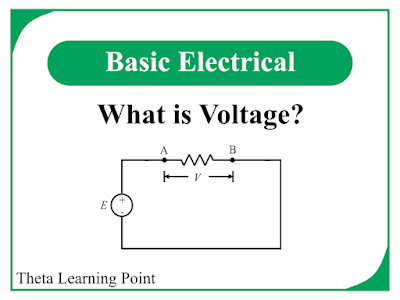This article will discuss the definition, formula, SI unit, types and significance of voltage in electrical circuits. So, let us begin with the definition of voltage.
Voltage Definition
Voltage is
defined as the amount of energy required to move a unit charge from one point
to another in an electric circuit.
In other words, the difference of potentials between two
points in an electric circuit is called voltage. Voltage is denoted by the
symbol “V”.
In an electric circuit, voltage acts as a pressure that
pushes the electric charges to travel. For this reason, voltage is sometimes
also called electric pressure.
As mentioned earlier, voltage is a difference of potentials
between two points. Thus, it is also known as potential difference. In electrical engineering, voltage is also
termed as electric tension.
Hence, potential difference, electric pressure, and electric
tension all are synonyms of voltage.
Voltage Formula
From the definition of voltage, we know that the amount of work
done to move a unit charge from one point to another in an electric circuit is
known as the voltage between those two points.
Therefore, in the circuit shown in figure-1, if the amount of work done to move a charge Q from point A to point B is W, then the voltage between these points of the circuit is given by,
Where, W is work done measured in joules,
and Q is charge measured in coulombs.
Voltage in an electric circuit can also
be given by Ohm’s law. In a given
electric circuit, if R is the resistance and I is the electric current in the
circuit, then the voltage is given by,
Where, R is measured in Ohms (Ω) and I is measured in
Amperes (A).
SI Unit of Voltage
The SI unit of voltage is Volt, represented by V. This unit of
voltage, i.e. volt, was named in the honor of the Italian physicist Alessandro Antonio Volta.
In an electric circuit, when 1 joule of
work is done to move a charge of 1 coulomb from one point to another, then the
voltage between those two points is said to be 1 volt.
Therefore,
Types of Voltage
There are two types of voltage given as
follows:
- Direct Voltage
- Alternating Voltage
(1). Direct Voltage:
Direct Voltage, also called DC Voltage,
is the type of voltage whose polarity always remains unchanged. Direct voltage
may be further classified into two types namely, Constant DC Voltage and Varying
DC Voltage.
The Constant DC Voltage is one whose
magnitude does not change with time. It is denoted by the symbol V. On the other hand, the Varying DC Voltage
(also called pulsating dc voltage)
is one whose polarity remains fixed, but the magnitude changes with time. The
varying voltage is generally denoted by the symbol v.
(2). Alternating Voltage:
An alternating voltage is a type of
voltage whose magnitude changes continuously and the direction changes
periodically. An alternating voltage is also called an AC voltage. It is denoted by the symbol v. In actual practice, we produce a sinusoidal alternating voltage by alternators.
AC voltage is further classified into
various types based on voltage level such as low voltage, high voltage,
extra-high voltage, ultra-high voltage, etc.
Important Point about Voltage
The following are some important points
about voltage:
- In any electric circuit, voltage or potential difference is always specified between two points, not at a single point.
- The point with higher potential is marked as a positive terminal and the point with lower potential is marked as a negative terminal.
- When a voltage is applied across two points of a conductor, then it forces current through the conductor to flow from the positive terminal to the negative terminal.
- If there is no voltage, no current can flow through the circuit. Hence, voltage is the driving force for the flow of electric current.
Numerical Example – Calculate the voltage
between two points in an electric circuit. If the work of 8 Joules is to be
done to move a charge of 4 Coulombs from one point to another.
Solution – Given data,
Work
Done, W = 8 J
Charge,
Q = 4 C
Therefore, the voltage between the two
points is,
`\"Voltage", V=W/Q`
`\∴V=8/4=2" Volts"`
Hence, this is all about voltage and its unit in electrical engineering.



.png)




